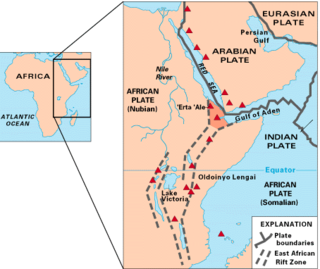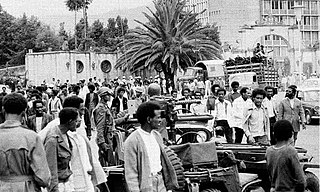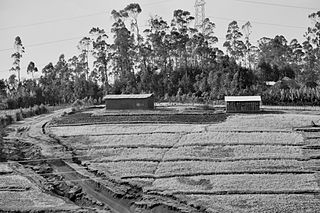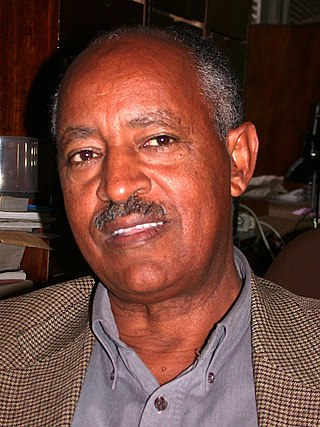
A widespread famine affected Ethiopia from 1983 to 1985. The worst famine to hit the country in a century, it affected 7.75 million people and left approximately 300,000 to 1.2 million dead. 2.5 million people were internally displaced whereas 400,000 refugees left Ethiopia. Almost 200,000 children were orphaned.

Mengistu Haile Mariam is an Ethiopian former politician and former army officer who was the head of state of Ethiopia from 1977 to 1991 and General Secretary of the Workers' Party of Ethiopia from 1984 to 1991. He was the chairman of the Derg, the socialist military junta that governed Ethiopia, from 1977 to 1987, and the president of the People's Democratic Republic of Ethiopia (PDRE) from 1987 to 1991.

The Derg, officially the Provisional Military Administrative Council (PMAC), was the Marxist–Leninist military dictatorship that ruled Ethiopia, then including present-day Eritrea, from 1974 to 1987, when the military leadership or junta formally "civilianized" the administration but stayed in power until 1991.

Amha Selassie was Emperor-in-exile of Ethiopia. As son of Haile Selassie, he was Crown Prince and was proclaimed monarch three times. He was first proclaimed Emperor during an unsuccessful coup attempt against his father in December 1960, during which he alleged that he was detained and compelled to accept the title. After his father was deposed in a later coup, he was proclaimed King in absentia by the Derg on 12 September 1974 in an act which he never accepted as legitimate and that ended in the abolition of the Ethiopian monarchy on 21 March 1975. He was again proclaimed Emperor in exile on 8 April 1989. This time he sanctioned the proclamation and accepted its legitimacy. After his accession, his full reign name was His Imperial Majesty Emperor Amha Selassie I, Elect of God, Conquering Lion of the Tribe of Judah and King of Kings of Ethiopia.

The People's Democratic Republic of Ethiopia was a socialist state that existed in Ethiopia and present-day Eritrea from 1987 to 1991.

The Afar Triangle is a geological depression caused by the Afar Triple Junction, which is part of the Great Rift Valley in East Africa. The region has disclosed fossil specimens of the very earliest hominins; that is, the earliest of the human clade, and it is thought by some paleontologists to be the cradle of the evolution of humans. The Depression overlaps the borders of Eritrea, Djibouti and the entire Afar Region of Ethiopia; and it contains the lowest point in Africa, Lake Assal, Djibouti, at 155 m (509 ft) below sea level.

The Ethiopian Civil War was a civil war in Ethiopia and present-day Eritrea, fought between the Ethiopian military junta known as the Derg and Ethiopian-Eritrean anti-government rebels from 12 September 1974 to 28 May 1991.
Metehara is a town in central Ethiopia. Located in the East Shewa Zone of the Oromia Region, it has a latitude and longitude of 08°54′N39°55′E with an elevation of 947 meters above sea level.

The problem of land reform in Ethiopia has hampered that country's economic development throughout the late 19th and 20th centuries. Attempts to modernize land ownership by giving title either to the peasants who till the soil, or to large-scale farming programs, have been tried under imperial rulers like Emperor Haile Selassie, and under Marxist regimes like the Derg, with mixed results. The present Constitution of Ethiopia, which was put into force January 1995, vests land ownership exclusively "in the State and in the peoples of Ethiopia." The relevant section continues, "Land is a common property of the Nations, Nationalities and Peoples of Ethiopia and shall not be subject to sale or to other means of exchange." Despite these different approaches to land reform, Ethiopia still faces issues of sustainable food self-sufficiency.

Berhane Asfaw is an Ethiopian paleontologist of Rift Valley Research Service, who co-discovered human skeletal remains at Herto Bouri, Ethiopia later classified as Homo sapiens idaltu, proposed as an early subspecies of anatomically modern humans.

Bitwoded Sultan Alimirah Hanfare was Sultan of Aussa from 1944 until his death in 2011. He ascended to the throne after his predecessor and uncle, Mohammad Yayyo.

The Woyane rebellion was an uprising in the Tigray Province, Ethiopia against the centralization process from the government of Emperor Haile Selassie which took place in May–November 1943. The rebels called themselves the Woyane, a name borrowed from a game played locally between competing groups of young men from different villages, which connoted a spirit of resistance and unity. After nearly succeeding in overrunning the whole province, the rebels were defeated with the support of aircraft from the United Kingdom's Royal Air Force. Out of all the rebellions that engulfed Ethiopia during Haile Selassie's rule, this was the most serious internal threat that he faced.

The fall of the Derg, also known as Downfall of the Derg, was a military campaign that resulted in the defeat of the ruling military junta, called the Derg by the rebel coalition Ethiopian People's Revolutionary Democratic Front (EPRDF) on 28 May 1991 in Addis Ababa, ending the Ethiopian Civil War. The Derg took power after deposing Emperor Haile Selassie and the Solomonic dynasty, an imperial dynasty of Ethiopia that began in 1270. The Derg suffered from insurgency with different factions, and separatist rebel groups since their early rule, beginning with the Ethiopian Civil War. The 1983–1985 famine, the Red Terror, and resettlement and villagization made the Derg unpopular with the majority of Ethiopians tending to support insurgent groups like the Tigray People's Liberation Front (TPLF) and Eritrean People's Liberation Front (EPLF).
This list details about chronological aspect of the Derg, the military junta that ruled Ethiopia from 1974 to 1987 by decade.

The Ethiopian Civil War (1974–1991) has costed civilian, infrastructure and agricultural impacts. It left at least 1.4 million people dead, with 1 million related to famine and the remainder from violence and conflicts, which is one third of population.

Opposition to Haile Selassie relied largely of internal administration of his country. While Haile Selassie made attempt to modernize the country and brought to global power since Italy's occupation in 1936–41, the later administration met with negative public attitude especially among educated people in universities and peasants.

On 12 September 1974, Emperor Haile Selassie was deposed by the Coordinating Committee of the Armed Forces, Police, and Territorial Army, a Soviet-backed military junta that consequently ruled Ethiopia as the Derg until 28 May 1991.

The Ethiopian Revolution was a period of civil, police and military upheaval in Ethiopia to protest against the weakened Haile Selassie government. It is generally thought to have begun on 12 January 1974 when Ethiopian soldiers began a rebellion in Negele Borana, with the protests continuing into February 1974. People from different occupations, starting from junior army officers, students and teachers, and taxi drivers, joined a strike to demand human rights, social change, agrarian reforms, price controls, free schooling, and releasing political prisoners, and labor unions demanded a fixation of wages in accordance with price indexes, as well as pensions for workers, etc.

This is a chronology of the lifetime of Ethiopian Emperor Haile Selassie.
The 1958 Tigray famine was a provincial famine in the Ethiopian Empire during the reign of Emperor Haile Selassie.

















